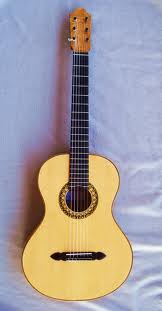Division of guitars according to the music style in which it has the most usage
This group includes tools that have been specifically tailored for a particular musical style.
Jazz guitar
It has two eyepieces on the front plate (eph), similar to the violin. It is characterized by high clutter and a sharp, penetrating tone. Mostly these are electro or acoustic guitars. A typical representative is Gibson Guitar.
Flamenco guitar

The flamenco guitar is required to have a clear and fast tone on the button (that is, the string does not last for a long time than the wood body of the guitar sounds) and a quick fade, otherwise all rhythmic techniques such as rasgueo, rasgueado or alzapua will lose its impact, and especially rague, would merge into a clutter of sounds.
Among the other differences compared to the classic guitar include low-lying strings and golpeador.
The low strings have two functions: proximity to the fingerboard facilitates legato play, very often in the flamenco guitar used, proximity to the soundboard makes it easy to punch the fingers into the sound recorder (golpe). Since golpe is usually played alongside strings, the distance of the soundtrack from the strings plays a significant role.
A thin sounding board must be protected against fingerprints - otherwise it would soon be a hole (as seen from Manitas de Plata guitar). To do this, a thin protector (golpeador) is stuck around the eyepiece. The Golpeador is either white or more transparent (many flamenco guitars are sold today without a golpeador, which is available in particular as a plastic sticker that can be replaced from time to time).
Wikipediawww.bgcz.net
www.flamenco.cz





